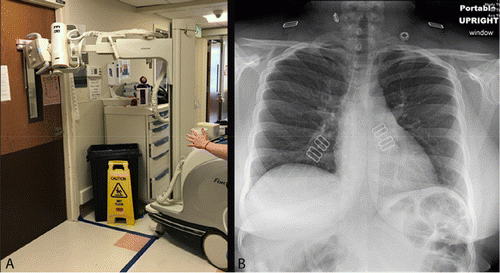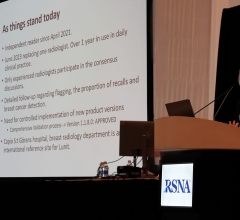
Chest radiography through glass. Technologists position the portable X-ray unit outside the patient room, with the tube peering through the wire-reinforced isolation room window (A). AP chest X-ray through obtained is of diagnostic quality (B). Courtesy of the journal Radiology
April 10, 2020 — Radiology departments must prepare for patient surges through streamlined approaches to imaging that will limit exposures to healthcare workers and patients, according to a new article published in Radiology. Researchers in Seattle, where the COVID-19 pandemic initially presented in the U.S., discuss the processes that have been implemented at the University of Washington in managing the COVID-19 pandemic as well in preparing for patient surges, which may provide important guidance for other radiology departments who are in the early stages of preparation and management.
The Coronavirus Disease 2019 (COVID-19) pandemic initially presented in the United States in the greater Seattle area, and has rapidly progressed across the nation in the past 2 months, with the United States having the highest number of cases in the world. Radiology departments play a critical role in policy and guideline development both for the department and for the institutions, specifically in planning diagnostic screening, triage, and management of patients. In addition, radiology workflows, volumes and access must be optimized in preparation for the expected COVID-19 patient surges. This article discusses the processes that have been implemented at the University of Washington in managing the COVID-19 pandemic as well in preparing for patient surges, which may provide important guidance for other radiology departments who are in the early stages of preparation and management.
Essential Policies and Guidelines
The essential policies and guidelines established include:
- Radiology policy goals are to reduce COVID-19-related morbidity and mortality through early diagnosis, appropriate treatment and prevention of disease dissemination.
- Imaging currently is not routinely used to screen for COVID-19 unless access to RT-PCR results for COVID-19 is limited.
- Postponing elective imaging and procedures will preserve resources and hospital beds, while also limiting patient population exposures.
- Determination of time-sensitivity of procedures and imaging tests is by consensus with input from radiologists, patients and/or ordering clinicians.
The article also outlines details on elective imaging exams, lab testing, imaging of COVID-19 positive or suspected patients, protection of radiology staff, room cleaning, sick or exposed employees, invasive procedures in COVID-19 patients, distribution of patients for imaging procedures, radiology faculty and staff protections, enterprise-wide coordination and communication and disaster preparedness.
For more information: RSNA.org/COVID-19
Related Coronavirus Content:
VIDEO: Imaging COVID-19 With Point-of-Care Ultrasound (POCUS)
The Cardiac Implications of Novel Coronavirus
CT Provides Best Diagnosis for Novel Coronavirus (COVID-19)
Radiology Lessons for Coronavirus From the SARS and MERS Epidemics
Deployment of Health IT in China’s Fight Against the COVID-19 Epidemic
Emerging Technologies Proving Value in Chinese Coronavirus Fight
Radiologists Describe Coronavirus CT Imaging Features
Coronavirus Update from the FDA
CT Imaging of the 2019 Novel Coronavirus (2019-nCoV) Pneumonia
CT Imaging Features of 2019 Novel Coronavirus (2019-nCoV)
Chest CT Findings of Patients Infected With Novel Coronavirus 2019-nCoV Pneumonia
Find more related clinical content Coronavirus (COVID-19)
ACC COVID-19 recommendations for the cardiovascular care team
VIDEO: What Cardiologists Need to Know about COVID-19 — Interview with Thomas Maddox, M.D.
The Cardiac Implications of Novel Coronavirus
ESC Council on Hypertension Says ACE-I and ARBs Do Not Increase COVID-19 Mortality


 December 02, 2024
December 02, 2024 








